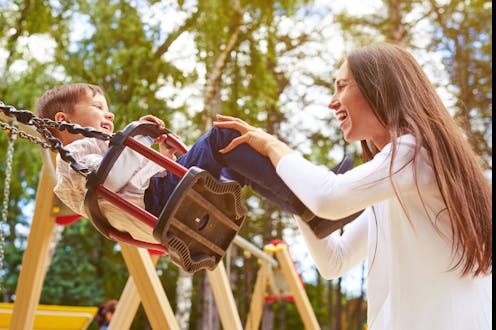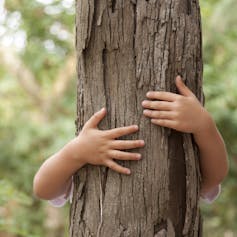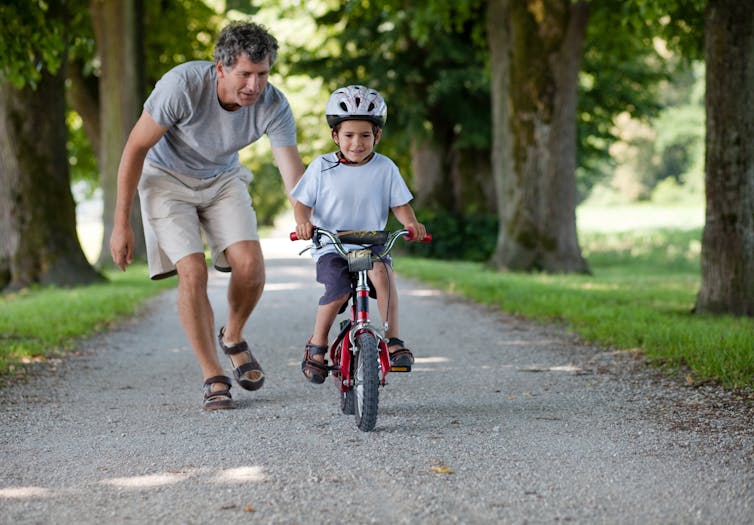 ArtFamily/Shutterstock
ArtFamily/ShutterstockAre you a parent who is struggling to find time to be with your child and help them grow? Our newly published research shows neighbourhood parks, and playgrounds in particular, provide valuable and unique opportunities for interaction between parents and children. These are places where parents can play with and teach their child new skills, and children also get to play with other children and create their own activities.
Read more: Public places through kids' eyes – what do they value?
In Australia, the proportion of couples with children under 18 where both parents are working has increased from 52% in 1991 to 61% in 2016. Parents are more time-poor than ever. Both parents often feel pressure to work full-time to maintain living standards, but it leaves them with less family time.
Some children are fine with having less time with mum and dad. However, many don’t feel close to their parents, especially their dad, who is often the main income earner.
 Parks are places where children can explore and experience nature.Helder Almeida/Shutterstock
Parks are places where children can explore and experience nature.Helder Almeida/ShutterstockSpending time outdoors allows children to experience nature and play in ways that are not limited by walls or fences. The experience may also provide parents with insights into their child’s interests and abilities and help them better understand their child’s needs.
For our research, we interviewed adults visiting 12 parks in residential neighbourhoods within the Moreton Bay Region of south-east Queensland, Australia. We completed 386 interviews from December 2017 to March 2018.
Read more: 'I need nature, I need space': high-rise families rely on child-friendly neighbourhoods
What has the research found?
According to the parents, grandparents and caregivers we interviewed, visiting the park provided opportunities for parents to teach their children productive social skills while playing with other children. This included taking turns, not pushing in, and showing respect. One interviewee said:
I think one of the best things in the park is developing their social skills, so they will meet with other kids and they learn to share toys and play together.
At the park’s playground, the parent could teach their child how to use equipment and help them climb around.
Generally, when I take them to the park, especially if you’ve got a younger one, you’re helping them to climb stuff and push them on the swing.
The adults were also concerned about keeping children safe.
Because he’s little, I like to be there. Especially for the climbing things, just in case he falls.
As children get older, they don’t need as much physical help from parents and can play with their siblings and other children on their own. Parents of older children start to take on more of a supervisory or observation role.
Most times, I sit back and let them play, only because of their ages. Sometimes, I get in and play, but I don’t find I need to.
Read more: That public playground is good for your kids and your wallet
Where do children play in parks?
Not all parks are designed and built with the same purpose in mind. They vary in size, facilities and types of playground equipment. In the 12 parks, children most frequently played at playgrounds (82%), followed by open fields (17%) and pathways (14%).
Playgrounds allow children to climb, swing, ride and slide on equipment.
There’s climbing, there’s balance activities and there’s lots of different stuff to do, to keep him engaged.
Open fields are great for intergenerational interaction and shared activities, including ball games and running around.
The grassy space is great because they can either bring equipment or two of my daughters are cheerleaders, so they’ll often run and do flips because it’s such a nice, big space.
Pathways can be used for bike riding.
I think we brought them here when they were new at learning to ride their bike, because it’s got the concrete path all around.
 Parents value parks as safe places for activities like learning to ride a bike.MinDof/Shutterstock
Parents value parks as safe places for activities like learning to ride a bike.MinDof/ShutterstockRead more: Worn, uneven, flooded: young people need better parks to get out and play
The local park makes for easy access to a space where parents can share in the activities of their children and teach them a range of physical and social skills that might not be possible within the limits of a backyard or home.
Our research is part of a larger study on designing suburban parks for all. Among the final outcomes are design recommendations for parks that are more inclusive of all ages for healthy, active living.
In a well-designed park, the child can explore their curiosity, take risks, learn outdoor skills and play with other children, all under the guidance and supervision of their parent or carer.
These unique social dynamics may not happen at other times of the day or week. If you are struggling to find time to help your child grow, try spending 30 minutes together in the local park – you will both benefit from playing, learning and laughing together!
Tracy Lynn Washington receives funding from the Australian Research Council. The project described in this article represents a collaboration between QUT researchers and the Moreton Bay Regional Council, Playscape Creations, the National Heart Foundation of Australia, the 7 Senses Foundation, Conrad Gargett, and the National Wellness Institute of Australia.
Debra Flanders Cushing receives funding from the Australian Research Council.
Laurie Buys receives funding from the Australian Research Council
Stewart Trost receives funding from National Health and Medical Research Council, Australian Research Council, and Queensland Children’s Hospital Foundation
Janelle MacKenzie does not work for, consult, own shares in or receive funding from any company or organisation that would benefit from this article, and has disclosed no relevant affiliations beyond their academic appointment.
Authors: Tracy Lynn Washington, Lecturer and Researcher in Urban and Regional Planning, Queensland University of Technology
Read more https://theconversation.com/why-working-families-need-parks-and-playgrounds-more-than-ever-132097
| < Prev | Next > |
|---|








